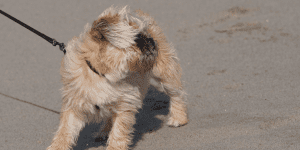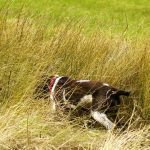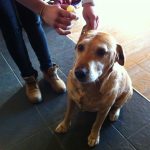Helping The Nervous Dog.
Dogs of all types and breeds can be nervous for a number of reasons. Lack of socialisation, exposure to frequent negative situations or, genetic predisposition. This Holidays4Dogs article provides information for people who own, or care for, nervous dogs. We suggest some ideas for helping the nervous dog. However, for more serious cases of aggression – especially towards people, or other dogs, please refer to a qualified behaviourist.
The most important thing to consider when dealing with a nervous dog is never to force him, or her, to ‘face their fears’. In basic terms, dogs will usually feel they have two options – flight, or fight. Generally, dogs will first seek to escape a situation they find to be of threat. If escape is not an option, the only alternative will be to fight.
Signs your dog may be nervous;-
Cowering.
Shaking, shivering.
‘Whale’ eye.
Lip curling, growling, lunging/snapping – (especially when on the lead).
Avoidance.
Rolling on back/submissive behaviour.
Low tail wagging.
A positive approach to the nervous dog.
There are many positive ways to desensitise the shy, or nervous dog. Helping the nervous dog should never involve punishment or force. A well-planned training programme usually produces good results over time.
For dogs with a genetic predisposition to weak nerves, improvement can be made. However, this could be a much longer process and may entail a lifelong approach to managing the dog day to day. It will be important not to put the dog into situations he is unable to cope with. If you need to board your dog, it is important to find an experienced home-from-home dog carer, who will have experience with nervous dogs.
Dogs with a predisposition to be fearful are frequently known not ‘graduate’ their response to a threat. In other words, instead of warning signs such as lip curling, or growling, they may bite in the first instance and without warning. This is a serious situation requiring one-to-one professional help.
Socialisation.
Careful socialisation of the young puppy is essential for the dog to develop into a confident adult. Careful exposure to different positive experiences, will help equip the dog with skills to interact positively with humans, dogs and other animals.
What we deem to be inappropriate behaviour in dogs, are in actual fact, quite normal responses. This is a significant point to bear in mind when dealing with a nervous dog. Many owners experience distress because they believe their dog is behaving in an unnatural, or unruly, manner.
A dog may be fearful of one, or multiple objects, or environments. He may fear men in hats, umbrellas or, loud noises, for instance. Another may be anxious about travelling in a car or, have a fear of other dogs. Some of the more common fears in dogs are outlined below, along with some basic tips on how owners should respond.
However, in very problematic cases, especially ones where the dog is inclined to show aggression, it is essential that the owner seeks professional assistance. Sudden nervousness, or aggression, must be referred to a vet immediately.
Fear of Novel Situations.
This can be a fairly common observation in young puppies. Puppy fear periods can occur at around, 4 to 6 months and again, anytime between 12 and 18 months. Socialisation should always be regarded as an ongoing prospect and not end at 16 weeks. The growing dog should be continually exposed to a variety of different of positive experiences through to adulthood.
Be careful not to force the fearful dog if he appears distressed. In studies with mice, it was found that subjects placed into novel situations, without any means of escape, were much more fearful. Mice which were provided with the opportunity to control how, and when, they approached something novel – from a safe vantage point for, example – were more confident, as a result.
Try to give the dog plenty of space and a loose lead – thereby providing an ‘escape option’. If your dog needs to back away, allow him to do so.
It is important for dogs to investigate objects in their own time, without too much intervention. It is equally important to raise the puppy using positive reward based methods.
Studies have shown that puppies who receive punishment associated with house-training, for example, have reduced confidence in exploring novel situations. This strongly supports the use of appropriately timed, reward-based methods.
Fear of strangers, or visitors to the home.
If your dog is shy about meeting unfamiliar people, or visitors to the home, it is important to try and ensure people ignore your dog to begin with. Some people will find it difficult not to try and ‘coax’ the dog into greeting. However, this is a form of ‘force’ which, as we have already discussed, should be avoided.
Advocate for your dog and ask people you meet, or visitors to the house, not give your dog eye contact, stoop over him, or try other tactics to force him to respond more quickly than he is comfortable with. Allowing the dog to approach people in his, or her own time, is the best way of helping the nervous dog.
You could ask people to drop a tit bit, or two, on the floor, but without communicating in any other way. Gradually, you should find your dog relaxing in the company of strangers over time. Dog crates can be useful for shy dogs as a place where they feel safe. However, you will need to train your dog to be comfortable in your crate – don’t just lock him in it when visitors arrive, but provide him with a stuffed Kong, or similar.
Fear of other dogs.
It can be surprising to find an animal who has roots entrenched in living as a pack, to be fearful of animals of the same species. However, just like people, dogs can be happy in their own company and not fussed about being social butterflies.
If your dog is nervous of other dogs, you will notice the same response to every dog he, or she meets. However, this can be different in different individuals. Some will cower, or attempt to run. A common response is for the dog to bark, or lunge, towards the ‘threat’.
Taking a dog like this to places frequented by large numbers of other dog walkers can be problematic. Not least because, you cannot be certain how other owners will handle their dogs. It is essential that you ‘set up’ good experiences by selecting calm dogs for your dog to meet.
A dog training club may be able to help you with this or, you may have friends, or neighbours with suitable dogs. Shy dogs can gain confidence from being around other stable dogs and will have the tendency to emulate their fellow canines. Practice loose-lead walking separately. Pulling on the lead makes the dog more hyper. Additionally, it can make the dog feel trapped, with no means of escape.
Fear of other dogs can be fairly complex issue to address. Therefore, it would be advisable to seek professional advice when helping the nervous, or reactive dog.
The yellow dog campaign for reactive dogs.
Some dogs never completely lose their anxieties, especially around other dogs. Unfortunately, improvements you make can be dramatically reversed should your dog encounter a boisterous, or aggressive dog while out walking. In this case, you will need to look upon it as a long term management issue.
The yellow dog campaign is a useful resource for people with nervous, or reactive dogs. In addition, you can purchase space awareness products such as yellow leads and harnesses from myanxiousdog.co.uk
Other points to consider.
Diet can have an effect on behaviour, so it may be worth looking into this, with the advice from your vet. Bach flower remedies and some herbal products, are said to help in cases of low level shyness in dogs. Skullcap and Valerian is a popular choice amongst owners of nervous dogs. There have been some investigations into the use of ASMR (Autonomous sensory meridian response ) in helping the nervous dog. However, research is in its infancy.
Conclusion.
For any signs of fear, or shyness, in a dog it is crucial that the owner always remains sympathetic and patient. Persistence and consistency, while important in any dog training efforts, are most essential when dealing with the nervous dog. Never try to speed up the process of behaviour modification as this will reduce the chances of improvement.
For more serious cases of aggression – especially towards people, or other dogs, please refer to a qualified behaviourist.


